- Home
- Nevil Shute
Stephen Morris and Pilotage Page 5
Stephen Morris and Pilotage Read online
Page 5
Morris walked on to where the cars were, and into a building of offices. Here he knocked on a door marked ‘Inquiries’ and opened it, to find a small girl seated by a telephone eating an apple.
‘Er, can I see Captain Rawdon?’ he said.
‘He’s down in the shops, sir,’ said the child cheerfully.
There was a short pause.
‘Do you know when he’ll be back?’ asked Morris.
The little girl looked surprised. ‘No, sir - I’d go down there if I were you.’ Then, with a sudden access of patronage, ‘I’ll take you down, if you like.’
Morris followed her humbly out of the building, down an alley between various sheds and stores, through a penetrating reek of pear drops. Presently his guide swung through a doorway into a big erecting shop, crowded with aeroplanes in every stage of completion. Most of them, Morris saw, were old Rabbits and Ratcatchers brought from store to be overhauled and reconditioned for the Air Force. In the midst was a new fuselage of a different type in the early stages of construction.
This was the new two-seater fighter, designed experimentally for the Air Ministry to take the new Blundell engine, the Stoat. Great things were expected of the Stoat; the lightest engine for its power yet produced. Rawdon had abandoned the unequal competition for nomenclature and had originated a system of ciphers for his machines which, though less exciting, imposed less strain upon the imagination of the designer. This was to be the Rawdon S.F. Mark I.
At present the board of directors was sitting on it, both metaphorically and physically. Whenever Bateman, the business director, came down from London to visit the firm, Rawdon usually took him to the shops where the exact progress of the work could be seen and proposed innovations illustrated more graphically than in the office. Morris saw them from a distance deep in conversation, and instinctively hung back.
His guide, however, had no such scruples as to the sanctity of a directors’ meeting. Apple in hand she marched up to Rawdon.
‘A gentleman to see you, sir.’ Her part played, she gave her attention to a more important matter. The foreman of the engine shop, passing by, stopped and regarded her.
‘Hey, Gladys, don’t you know any better than that up in the office?’ he inquired pleasantly. ‘Standin’ eating an apple in the middle of the shop! Settin’ a bad example to the men. Ought to be ashamed of yourself – I would. I wouldn’t have it if this was my shop.’
One of the carpenters laid down his work. ‘Don’t you pay no attention to him,’ he said. ‘He’d have apple and all if this was his shop.’
The little girl grinned shyly and strolled away. Rawdon levered himself slowly off the bright wooden fuselage and went to meet Morris, frowning a little. He had no place for this chap; he diagnosed instantly what he wanted. He hated having to turn people away.
As Morris unfolded his tale, however, the frown melted away and was replaced by a childlike look of innocence that usually rested on his features. He heard him to the end with a penetrating question now and then, and volunteered no comment. Morris finished his tale, and stood while Rawdon stroked his chin.
‘As I understand it, then, Mr Morris,’ he said, ‘you want to come and work for us unpaid for a certain time in the hopes that we can take you on when you’ve got a little experience or, failing that, that we can pass you on to someone who wants staff?’
Morris assented.
Rawdon picked up a splinter of wood and fingered it. ‘I’m afraid I can tell you straight off,’ he said, ‘that we shall not be taking on any more staff just yet – so far as I can judge. One doesn’t see very far ahead in this business. But unless anything very startling happens, we shan’t be engaging any more technical staff for many months.’
‘I expected that,’ said Morris. ‘At the same time, I want to get experience in these matters. Can you see your way to allow me to come and work unpaid? Of course, I quite see that the presence of a learner rather interferes with the work of the office.’
‘Oh, as to that,’ said the designer, ‘you can come and welcome – it’s all clear gain to us. And when you go, I’ll give you what help I can – with consideration to what you’re worth. But I must tell you clearly that I don’t think there’s a chance of a job for you in this firm. I’m sorry, but you know the state of the industry.’
Morris laughed. ‘I think I know a good bit about that,’ he said.
‘One thing, Mr Morris. Are you prepared to take any piloting work?’
Morris considered in his turn. ‘Piloting is my only asset,’ he said. He glanced at the other. ‘I should want flying pay for that.’
‘Quite so. We might be able to give you odd, isolated jobs in that way – delivery of these Rabbits chiefly. You would be willing to take that on?’
‘Most certainly.’
‘Well,’ said the designer, ‘we should be very glad to have you on those conditions, Mr Morris – only, as I say, I’m afraid there’s very little hope of a paid job in the office. Things are too bad to take on any more staff at present. When would you think of coming?’
‘In about three weeks? I really can’t say till I’ve spoken to Mr Riley; I’m still engaged to him.’
‘That would do very well. If you’ll give us a couple of days’ notice, will you? … Good morning, Mr Morris; I’m very glad we’ve been able to come to some arrangement.’
He walked back to his partner, still sitting on the fuselage of the fighter, and recounted the interview.
‘And you told him he could come,’ said Bateman.
‘Yes,’ said Rawdon, ‘I told him he could come. Fact is, I like the look of him, and there’s no denying that a regular resident pilot would be useful.’
‘I thought you said there wasn’t enough work for a regular pilot.’
‘There isn’t,’ said the designer. ‘But a pilot who can do something else as well is another matter.’
‘See how he shapes,’ suggested the partner.
‘Yes,’ said Rawdon, ‘we must see how he shapes.’
Chapter Four
Morris made his way back to London on top of the tram. Things had gone well, as well as could be expected; he had got his nose into another and more permanent side of the industry, something in which there were real prospects. At the moment, of course, it was unlikely that he would get a job on the design side; still, if he could continue to work there and make enough by casual piloting to keep himself in a modest way, he might in time be able to insinuate himself into the office of some firm. He had made a satisfactory start, anyway.
Back in the hut that evening, he told them all about it.
‘He asked about the piloting himself, did he?’ said Riley thoughtfully. ‘Play that well; it’s evidently your best line at the moment.’
‘I think he’s done pretty well out of the whole business, if you ask me,’ said Stenning. ‘Wish I had the luck some people have.’
‘It doesn’t mean anything but casual work,’ said Morris.
‘He hasn’t got any other pilots there, has he?’ asked Stenning.
‘Don’t think so,’ said Morris taking off his boots by the stove.
‘Well then, you’ll be chief pilot, test pilot if you like, to the Rawdon Aircraft Company Limited.’
Morris glanced at him quickly, one boot on and one off. Then he realised that his leg was being pulled, and made the appropriate comment.
‘No, really,’ said Riley, ‘that’s what it may come to if you can work it properly. I don’t see at all why it shouldn’t. Rawdon gave up flying himself last year, I heard. And he’s been getting in casual pilots, you say?’
Morris did not answer the question. ‘Don’t know if you call delivering Rabbits and Ratcatchers test flying,’ he said sourly. ‘Nothing to test.’
‘No satisfying some people,’ said Stenning.
Morris picked up his boots and went to put them in a corner, treading delicately in his stockinged feet. He turned and spoke bitterly over his shoulder to Stenning.
‘Neve
r seen such a ragtime show in all my life as that. I told you that the hall porter was a little girl eating an apple, didn’t I?’
‘Very nice too,’ said Riley. ‘Symbol of innocence. Besides, it’s aviation.’
Morris laughed. ‘It’s aviation all over,’ he said.
That week the receipts dropped sharply, though there was still a slight surplus to divide. Things the week after were better again, and worse the following week, when there was not sufficient to cover the statutory limit for depreciation and spares.
Then the crowning blow fell, with dramatic suddenness. One morning they became aware of strangers in the land, odd people wandering about the aerodrome. The caretaker announced that they were workmen from the Air Ministry, come to see about the buildings. A brief reconnaissance revealed the fact that they had commenced to remove the roof, door, and window-frames from one of the hangars; that they were proposing to treat every building in the place in a similar manner, and that the material was to be re-erected in an Air Force station on the other side of the Solent, where it was needed more urgently.
‘We’re done,’ said Riley when this was reported to him. ‘This is the end of us. We’ve got no legal tenure here – we’ve only had this place on sufferance.’
They decided not to dispute the edict, but to shut up shop and go. Riley had heard from his firm at Brooklands, who regretted that they had nothing to offer him at the moment, but in the near future they hoped to be making an attempt on some long distance records, when they would be glad to avail themselves of his services if he was still free. This was as good as could be expected. Stenning alone had nothing to go to, but hoped to pick up a piloting job if he hung about the London Terminal Aerodrome at Croydon long enough.
There was little preparation to be done. They sold most of their spares as junk to a speculative garage-keeper in Ryde and made the mechanic a present of what was left. The clerks were dismissed with a week’s wages, and a hangar was secured at Croydon for the housing of the machines till they were sold; there was more chance of selling them near London.
So one bleak morning in early October the three machines were pushed out of the hangars for the last time, and luggage loaded into them instead of trippers. The engines were started and one by one they moved out on to the aerodrome, spun over the grass, and circled for height above the hangars. Riley was the last to leave; he taxied out on to the aerodrome and waited a moment before taking off to join the others circling above his head. He sat in the machine idly for a little, and took a long look out over the wide grassy field, the derelict hangars. Once he had had bright visions for this place. He had hoped to make it a base for a sound taxi business about the south of England, to buy up the place bit by bit as he made money, and to run a big fleet of low-powered aeroplanes for hire.
Well, he had failed. He supposed he ought to have known better than to think that aviation would catch on … just yet. But it would come one day. He had failed and lost a lot of money on it. One day, in two or three years’ time, he would try again with more money behind him, when money was a little easier to get and the bank rate had come down.
He opened out his engine and began to move over the grass. The tail came up and he began to spin swiftly across the field; the uneven motion ceased and his castles in the air dropped away beneath him. Soon he was on a level with Stenning and Morris; in company they headed for Croydon.
An hour and a half later they arrived flying in formation of a sort, waited till an incoming Goliath from Paris had moved its unwieldy bulk from the centre of the aerodrome, and landed in quick succession one after another. They taxied to the side of the aerodrome, over the road to their hangar, and stowed the machines.
In an hour’s time their attentions to the machines were at an end; they collected their belongings in a little heap at the door of the hangar.
‘Nothing more to be done, is there?’ asked Morris.
‘Come and have lunch,’ said Riley. ‘There’s a Trust House here somewhere.’
In the restaurant Stenning and Riley found one or two acquaintances. There was a tone of optimistic anxiety about all their news and greetings; the advent of a ‘broke’ joy-riding concern had pointed the lesson to be learned from the diminishing number of passengers on the air lines. Aviation had ceased to attract as a novelty and was not yet accepted as a serious means of transport. The bulk of the passenger traffic was still represented by American tourists; still at the end of every trip the pilot was photographed in front of the machine with Sadie and Momma by his side. This was not the procedure adopted on the railways … and air transport must become as matter of fact as railway transport before it became a dividend paying business.
They lunched well, getting a little amusement by prophesying the gloomiest future for the regular air lines to the regular pilots. There was just sufficient uneasiness about for some attention to be given to them; they finished the meal and retired to the lounge in a perfect blaze of unpopularity. Riley paused in the door and fired the parting shot.
‘Well, of course, it’s nothing to do with me. But you can’t get away from those facts. I know, if I was on an air line now, I’d be looking out for something else, just in case.… There’ll be a glut of pilots on the market pretty soon. Still, it’s none of my business.’
They settled up the last financial details in the lounge and drank a round to their next merry meeting. Then they separated, Morris going up to London, Stenning and Riley to get rooms in the neighbourhood and to see if there was any chance of selling the machines. There was none.
Two days later Morris started work in the design office of the Rawdon Aircraft Company (1919) Ltd.
He did not find the work very difficult after the first few days. The whole business of designing an aeroplane he found to run on certain very definite lines. First of all, certain broad considerations governing the design of the machine came to the designer. Thus if it were a passenger machine for an air line, the air line had certain definite ideas as to what they wanted; the carrying capacity, the speed, the landing speed, and the ‘ceiling’ or maximum height that it was possible for the machine to attain. Such considerations as these would be settled in conference with the designer, who would indicate tactfully where they were asking for technical impossibilities. If the machine were a military one for the Air Force the procedure was, in general, much the same, with the difference that the purchaser had a habit of asking for technical impossibilities and refusing to discuss the matter. This made the design of military machines a very specialised business.
The conditions for the machine being determined, the chief draughtsman would draw a pretty picture of what he thought such a machine ought to look like, neatly indicating on this first layout the really important features of the machine, such as the way the door opened and the system of heating the cabin. This rough layout would be shown to the customer for approval; in the case of a commercial machine it would be passed without much question.
The procedure now depended very much upon the financial position of the firm. In war-time, when the firms were well to do, a model of the machine would be made at this point and tested in a wind channel. That is, it would be mounted on a special balance in a tunnel and air sucked over it at a known speed, the resulting ‘lift’ and forces on the model being accurately measured. From this date the performance of the machine, the speed and horse-power necessary could be easily determined and any alterations or improvements to the machine tried out.
This was the counsel of perfection, and a very expensive one. For firms that could not run to the expense of a wind channel – and this was the case with very many firms – there was another method, more laborious and less accurate. This consisted in keeping a careful record of every calculation that had ever been made in the firm since the early days of aviation, and digging in this turgid mass for figures and precedents which would assist in the estimation of the performance of the machine in question. In this the greatest help was given by the various government researc
h departments, who had collected and published a vast mass of aerodynamic data.
In the meantime, as soon as the main essentials of the machine had been decided, the span of the wings and the aerofoil section to be used, certain human calculating machines were let loose and proceeded to calculate the stresses and necessary size of every part of the machine in several different ways, from the main spars in the wings to the luggage racks in the cabin. And last of all, the results of their work were handed over to the draughtsmen, the really important people on whose work the detail design of the machine depended, and who got out the drawings upon which the men in the workshops were to act.
And over all brooded the designer, visiting each man’s desk once or twice a day, discussing and approving each man’s work with a faculty for switching his mind on to new subjects at a moment’s notice that gained Morris’s earnest respect. This seemed to be the true function of a designer, to criticise and advise his staff.
Time slipped quickly past; Morris found himself fairly competent to deal with the work that he was called upon to do; odd problems in research and experimentation. The design in hand was that of a torpedo carrier for the Air Ministry. A model was built and tested at the National Physical Laboratory at considerable expense, and was found to behave exactly as was expected. This was disappointing and a waste of money. Then came a galaxy of performance calculations, tangled by empirical allowances for imperfectly understood complications. By the time these difficulties were unravelled, the design of the machine was well on the way; they realised – as so often happened – that it was now too late to make any alteration even if they wanted to; there remained only to hope for the best.

 On the Beach
On the Beach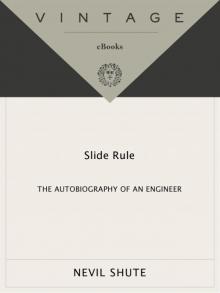 Slide Rule
Slide Rule A Town Like Alice
A Town Like Alice The Far Country
The Far Country Pied Piper
Pied Piper Round the Bend
Round the Bend An Old Captivity
An Old Captivity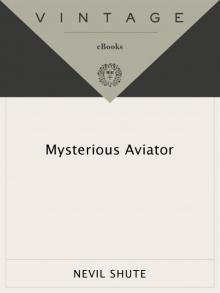 Mysterious Aviator
Mysterious Aviator The Breaking Wave
The Breaking Wave Marazan
Marazan Lonely Road
Lonely Road Pastoral
Pastoral No Highway
No Highway Stephen Morris and Pilotage
Stephen Morris and Pilotage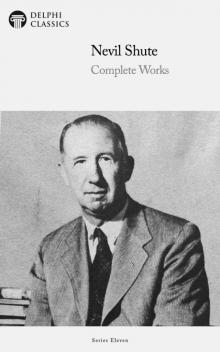 Complete Works of Nevil Shute
Complete Works of Nevil Shute Most Secret
Most Secret Beyond the Black Stump
Beyond the Black Stump The Rainbow and the Rose
The Rainbow and the Rose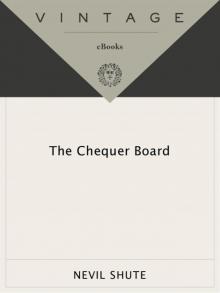 The Chequer Board
The Chequer Board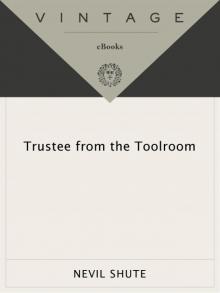 Trustee From the Toolroom
Trustee From the Toolroom Ordeal
Ordeal Stephen Morris
Stephen Morris